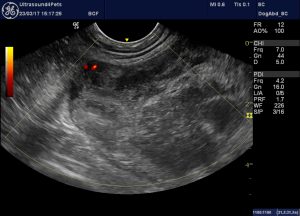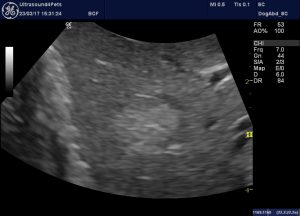Neoplastic fever in dogs
Neoplastic fever is an important differential for pyrexia. However, it’s easy to overlook the possibility and it’s also a phenomenon about which we know relatively little.
An excellent summary from human medicine can be found here:
http://www.clinicalcorrelations.org/?p=7966
I suspect that, as in people, hepatic masses (especially metastases) or lymphoma are the commonest culprits in dogs.
I’ve seen a couple of cases in the last 2 weeks:
This lurcher with a large, presumably primary, sublumbar mass and multiple, presumably secondary, hepatic target lesions presented with fever of 40.5C.

part of a large, heterogeneous mass attached to the ventral surfaces of the lumbar vertebrae

One of a number of hepatic target lesions with a hypoechoci periphery and hyperechoic centre
Although it’s possible that some cases may involve bacteria -for example within necrotic liver lesions. Most are unresponsive to antibiotics. Cytokines are thought to be important players. Interestingly, in people, glucocorticoids are relatively ineffective but response to naproxen (a propionic acid-derived NSAID) is consistent and is relatively specific since septic patients did not benefit.
Chang JC and Gross HM. Utility of naproxen in the differential diagnosis of fever of undetermined origin in patients with cancer. The American Journal of Medicine 1984;76(4):597–603. http://www.ncbi.nlm.nih.gov/pubmed/6711574
Chang JC and Gross HM. Neoplastic fever responds to the treatment of an adequate dose of naproxen. Journal of Clinical Oncology 1985;3(4):552–558.
http://www.ncbi.nlm.nih.gov/pubmed/3981226
In fact, in these case series, 90% of patients experienced relief of fever within 24 hours.
I’m not aware of any similar work in dogs. The most widely-used propionic acid derivative in the UK would probably be carprofen. It might be interesting to look at its efficacy in this regard.





